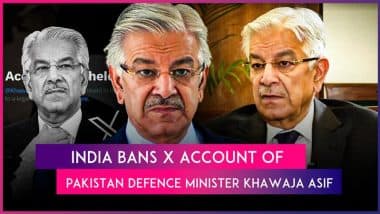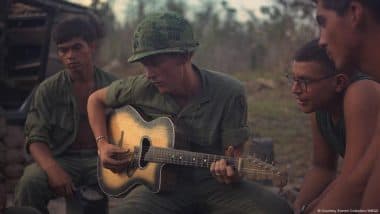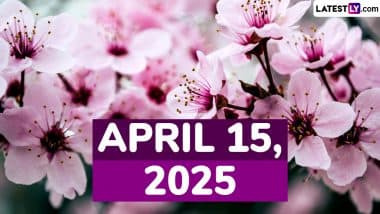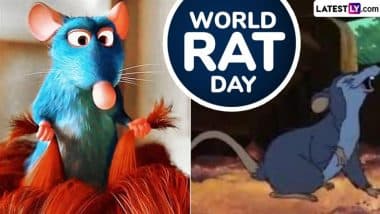The Vietnam War ended 50 years ago. What role did American protest culture, especially music, play in bringing the conflict to an end?On April 30, 1975, the Vietnam War ended with the conquest of Saigon by North Vietnamese troops.
But the US, which had been involved in the bloody proxy Cold War conflict for more than a decade, had already ended its direct military involvement in 1973.
Also Read | World News | Japan, Philippines to Start Talks on 2 Defence Pacts in Face of China’s Growing Aggression.
The reasons for this were complex, but one striking factor was domestic political pressure exerted by the country's pervasive pop protest culture.
700 songs against the war
"The 1960s were an important time of change in culture and society, when traditional barriers fell and youth music exploded," says Justin Brummer, who is an expert in the rich heritage of protest music from the era.
The Texas-based researcher is the founding editor and digital archivist of the Vietnam War Song Project (VWSP), a digital archive that also analyzes and interprets songs referencing the Vietnam War.
Since its inception in 2007, the VWSP has collected over 6,000 Vietnam War-related songs. Of these, Brummer has identified over 700 English-language protest songs released during the core war years (1964-1973).
Joan Baez, Crosby, Stills, Nash and Young, Creedence Clearwater Revival, Bob Dylan, John Lennon, Marvin Gaye, Martha Reeves, Pete Seeger, Edwin Starr all sang about and against the war.
The war permeated diverse genres of popular music in the US at the time. As war costs and US soldier fatalities began mounting, even the conservative, patriotic country music scene in the southern states began voicing criticism in the late 1960s.
Essential war anthem
"Due to the variety of song material and criticism, it is actually difficult to create a canon of the most influential songs," says Brummer. However, by focusing on the critical war years in the mid to late 1960s, American artists and public feedback, it is possible to identify a few "essentials."
For example, the frequently covered number one hit "Eve of Destruction" (1965) by Barry McGuire addressed the Vietnam War, politics and the nuclear threat. Or "Draft Dodger Rag" (1965) — by self-described "singing journalist" Phil Ochs — a satirical song on draft evasion during the Vietnam War.
And while many songs take aim at governments or politicians, "Universal Soldier," written by Canadian musician Buffy Sainte-Marie in 1964, and popularized by Donovan in 1965, addresses the complicity of individuals who agree to fight, thus enabling wars to be waged.
Meanwhile, "Ohio" (1970) by Crosby, Stills, Nash & Young criticizes the Kent State Massacre where on May 4, 1970, members of the Ohio National Guard opened fire on Kent State University students protesting the Vietnam War and the US invasion of Cambodia.
Shared experience of protest culture
Protest music from the mid-1960s became a vital part of pop culture, but its real influence emerged when it left the studio and entered public spaces.
In both the US and Vietnam, politically charged songs were experienced collectively, reflecting both technological advances and rising social unrest.
By the 1960s, millions of Americans owned portable radios, record players, and later audio cassettes (introduced in 1963), making protest songs easily accessible.
Music filled everyday spaces — cars, kitchens, parks and garages — and helped build a shared cultural experience. There was also a strong live music scene.
Bands performed for soldiers in Vietnam, who had brought music from home and often listened to protest songs together. Doug Bradley and Craig Werner explore this connection in their 2015 book, "We Gotta Get Out of This Place: The Soundtrack of the Vietnam War."
Protest music also accompanied major public events and demonstrations in the US.
In 1968, the "Composers and Musicians for Peace" concert in New York paid tribute to Martin Luther King Jr. shortly after his assassination.
A year later, Woodstock gathered hundreds of thousands in Bethel, New York, offering iconic performances and outspoken criticism of war and government. Jimi Hendrix's rendition of the American national anthem near the end of this festival is legendary. Playing on his Fender Stratocaster, his distorted version of the renowned melody elicited the wildest war sounds.
By November 1969, around 500,000 people protested in Washington, D.C., while several hundred thousand gathered in San Francisco, all demanding an end to the Vietnam War.
In 1971, the May Day protests saw over 12,000 people arrested — one of the largest mass arrests US history. Many of these movements were inspired and energized by protest songs that became the nation's unofficial soundtrack of resistance.
The Vietnamese perspective
Unsurprisingly, there was no (or at least no publicly perceived) protest music in North America in the 1960s and 1970s that looked at the war from a Vietnamese perspective. This only came later.
However, according to Brummer, hundreds of political songs were released in North Vietnam during the war, primarily on the state-run Dihavina label.
"Much of this music was known as Nhạc do ('Red Music')," the music historian explains. "A music that developed at the beginning of the 20th century and contained elements of Western classical music, while the lyrics focused on socialism and independence and expressed an anti-imperialist or anti-colonialist sentiment."
For instance, Trinh Cong Son (1939-2001), dubbed "the Bob Dylan of Vietnam," combined different musical styles but his political lyrics fell out of favor with censors in both North Vietnam and South Vietnam.
Stirring war film soundtracks
After the Vietnam War finally ended on April 30, 1975, its impact continued to shape American and global pop culture in the years that followed.
Several major anti-war films were released with powerful soundtracks, including "Apocalypse Now" (1979), "Platoon" (1986), "Full Metal Jacket" (1987), "Good Morning, Vietnam" (1987) and "Born on the Fourth of July" (1989).
In music, Bruce Springsteen's "Born in the USA" (1984) and Paul Hardcastle's "19," which was released a decade after the war, gained massive popularity and reignited public debate.
Both songs are considered key additions to the broader Vietnam War music canon compiled by the Vietnam War Song Project.
Pop and protest today
Comparing the musical output and reception of that era with today's, Craig Werner, who co-authored "We Gotta Get Out of This Place: The Soundtrack of the Vietnam War," told TIME in 2017: "There's a lot of very conscious music being made today. What there isn't is great music addressing the wars that is simultaneously very popular and widely shared."
Despite visible activism — like political posts from stars such as Taylor Swift, anti-Trump rallies, or songs supporting Black Lives Matter by the likes of Kendrick Lamar — there's no unifying protest movement with a defining soundtrack.
Unlike the Vietnam era, today's protests lack a single, focused cause. The US isn't involved in one major war, but is instead navigating a mix of domestic tensions and foreign policy issues. The former includes MAGA politics and anti-science sentiment, economic inequality, and even geopolitical provocations involving Greenland, Canada and Panama.
These scattered issues make collective protest harder to organize.
The music scene has also changed. With an overwhelming variety of genres and personalized listening via streaming, the shared cultural moments of the 1960s and '70s are largely gone.
This article was originally written in German.
(The above story first appeared on LatestLY on Apr 29, 2025 08:00 PM IST. For more news and updates on politics, world, sports, entertainment and lifestyle, log on to our website latestly.com).







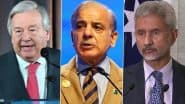





 Quickly
Quickly








